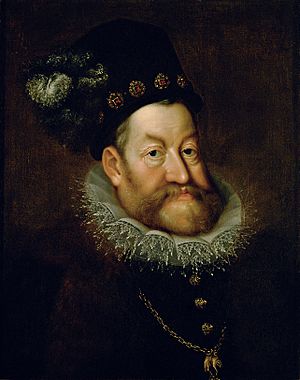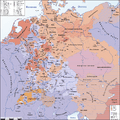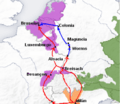Thirty Years' War facts for kids
Quick facts for kids Thirty Years' War |
|||||||
|---|---|---|---|---|---|---|---|
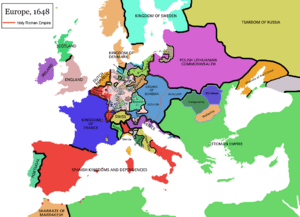 Map of Europe in 1648. The grey places are small German states within the Holy Roman Empire. |
|||||||
|
|||||||
| Belligerents | |||||||
(Catholic League) |
|||||||
| Commanders and leaders | |||||||
| Strength | |||||||
| ~475.000, 150.000 Swedes, 75,000 Dutch, ~100,000 Germans, 150,000 French |
~450,000, 300,000 Spanish, ~100-200,000 Germans |
||||||
The Thirty Years' War was a long and terrible war that lasted from 1618 to 1648. Even though most of the fighting happened in Germany, many other powerful countries in Europe got involved. These included France, Spain, and Sweden.
The war started because of disagreements about religion, mainly between Protestants and Catholics. But as the war went on, it became more about powerful families, like the Catholic Habsburg family, trying to gain more land and control. For example, Catholic France actually fought on the side of the Protestants to weaken the Habsburgs.
The Thirty Years' War caused huge problems like famine (not enough food) and disease across Europe. Millions of people died. The war finally ended with the signing of the Treaty of Westphalia.
Contents
Why the War Started
There were several important reasons why the Thirty Years' War began.
Religious Disagreements
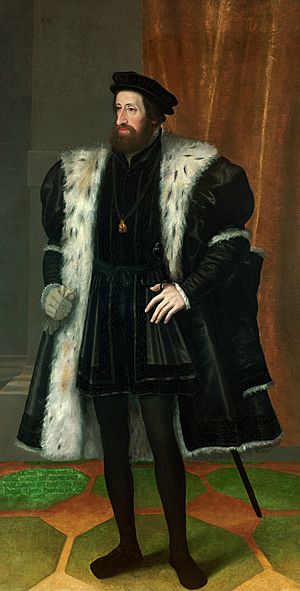
The first reason was about religion. In 1555, an agreement called the Peace of Augsburg was signed. This agreement tried to stop the fighting between Lutherans and Catholics in Germany.
The Peace of Augsburg said:
- Princes in Germany (there were 225 of them) could choose if their state would be Lutheran or Catholic. This was called cuius regio eius religio (meaning "whose realm, his religion").
- Lutherans living in areas ruled by a Catholic bishop could remain Lutheran.
- Lutherans could keep the land they had taken from the Catholic Church since 1552.
- If a Catholic bishop became Lutheran, they had to give back their church lands. This was called reservatum ecclesiasticum.
- People could not change their religion if their ruler had already chosen it for the state.
This agreement stopped the fighting for a while, but it didn't solve the deeper religious problems. Both sides understood the agreement differently. Also, a new Protestant group called Calvinism quickly grew in Germany, but the Peace of Augsburg didn't include them.
Political Power Struggles
Another big reason for the war was that powerful countries in Europe wanted more land and power.
- Spain wanted more land in the German states, especially because Germany controlled parts of the Spanish Netherlands. The Dutch were also fighting Spain for their independence.
- France was worried because the powerful Habsburg family ruled both Spain and the Holy Roman Empire, surrounding France. France wanted to show its strength to the weaker German states.
- Sweden and Denmark wanted to control the German states located near the Baltic Sea in the north.
Weakness of the Holy Roman Empire
The Holy Roman Empire was not one strong country. It was a collection of many smaller states, like Bavaria, Saxony, and Württemberg. Only Austria, ruled by the Habsburg family, was strong enough to act on its own. These smaller states often made alliances with relatives who ruled other places.
Growing Religious Tensions
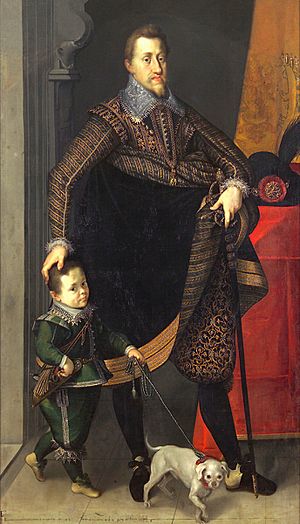
In the late 1500s, religious groups disagreed more and more. The Peace of Augsburg wasn't working well. Some Catholic bishops who became Protestant didn't give up their church lands. Also, Catholic rulers in Spain and Eastern Europe wanted to make Catholicism stronger everywhere. This led to fighting, and many Protestants were forced to leave their homes. These disagreements often led to violence.
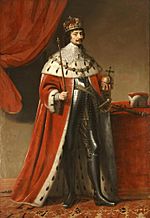
The Bohemian Revolt Begins
The war officially started because of a problem in Bohemia. In 1619, the Holy Roman Emperor Matthias died without children. His lands were given to his cousin, Ferdinand of Styria. Ferdinand had been taught by the Jesuits and was a very strong Catholic. He wanted to make Catholicism the only religion again.
This made him very unpopular in Bohemia, where many people were Protestant. They refused to accept Ferdinand as their king. Instead, they chose the Protestant Frederick V to be their king. This act of rebellion started the Thirty Years' War.
The war is often divided into four main parts:
- The Bohemian Revolt
- The Danish intervention
- The Swedish intervention
- The French intervention
The Defenestration of Prague
In May 1618, before Ferdinand officially became Emperor, he sent two Catholic officials to Hradčany castle in Prague. He wanted them to manage the government while he was away. However, some Bohemian Protestants captured these officials. They held a quick trial and then threw them out of a 20-foot-high palace window! This event is called the defenestration of Prague.
Amazingly, the officials survived and were not badly hurt. Catholics said that angels saved them, while Protestants joked that they landed in a pile of manure, which broke their fall. This dramatic event marked the beginning of the Bohemian Revolt and the start of the Thirty Years' War.
Related pages
Images for kids
-
Religious differences in the Holy Roman Empire just before the war began in 1618.
-
Habsburg lands in Europe around 1700.
-
The Spanish Road, a military route used by Spain.
-
A drawing from the time showing the Third Defenestration of Prague (1618), which started the Bohemian Revolt.
-
A painting showing the Battle of White Mountain (1620), where Imperial and Spanish forces won a big victory.
-
Albrecht von Wallenstein, a very successful general whose power worried many.
-
The Battle of Rocroi, a famous painting by Augusto Ferrer-Dalmau.
-
A sea battle off Goa between Dutch and Portuguese ships in 1638.
-
The Holy Roman Empire after the Peace of Westphalia in 1648.
See also
 In Spanish: Guerra de los Treinta Años para niños
In Spanish: Guerra de los Treinta Años para niños


